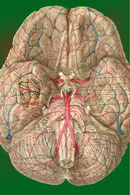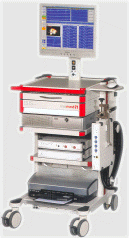|
|
 |
BLOOD-BRAIN BARRIER
Electron microscope studies have shown
that capillaries in the brain have a
continuous capillary endothelium with
tight junctions and are therefore unlike
the more permeable capillaries found
elsewhere in the body. This effectively
excludes the passage of many materials
including proteins and molecules with
molecular weights as low as 2000. The
existence of the barrier was first
demonstrated by Paul Ehrlich and later
by Goldman, who in 1909 injected large
amounts of the dye trypan blue into the
vascular circulation and observed that
all tissues became intensely stained
while the brain remained "snow white."
We now know that trypan blue was
excluded from the brain because it
rapidly complexed with albumen in the
plasma and could not cross cerebral capillaries in this form.
Many materials do, however, cross the barrier from plasma to
brain. Nevertheless, it's a "selective" barrier where some
materials are excluded or cross with difficulty and others pass
quite freely. Because of the heavy dependence of the brain on a
steady supply of oxygen for cellular respiration and glucose for
energy metabolism, it is not surprising to find that they pass
freely into the brain with little hindrance. Similarly,
metabolic wastes and carbon dioxide readily pass across the
barrier from brain to plasma. On the other hand, free fatty
acids, an easily accessible alternate energy source for most
other cells of the body including muscle, are virtually excluded
from the brain. A summary of the permeability of the blood-brain
barrier to several different metabolic substances is illustrated
in Fig. -1
 |
Diffusion Across the Barrier
O2, CO2, N2O, Kr, and
Xe are gases which readily diffuse across the barrier.
The latter three have been used to calculate cerebral
blood flow. Water also readily diffuses into and out of
the brain. Its net movement is dictated solely by the
osmolality of the plasma. Thus an increase in the plasma
osmolality from its normal value of 290 mosmol/L can
draw water from the brain by osmosis, and actually
shrink its volume. This phenomenon has been employed
clinically to reduce intracranial pressure by using
plasma expanders such as mannitol to increase plasma
osmolality. Mannitol does not cross the blood-brain
barrier.
Lipid solubility is an important factor in diffusion
across the barrier. Generally the higher the lipid
solubility of a substance, the more readily it diffuses.
Thus alcohols like ethanol move freely into the brain.
Lipid-soluble thiobarbital equilibrates more rapidly
between plasma and brain than the slightly less soluble
barbital does. Salicylic acid is less soluble yet and
thus requires even more time to equilibrate.
|
 |
Facilitated Transport across the Barrier
Carrier systems
appear to be involved in the transport of several
materials across the barrier. Glucose, ions, and certain
amino acids utilize this type of system. The carrier
system for glucose is stereospecific as n-glucose, but
not Lglucose, is readily transported into the brain.
Lactic, pyruvic, and acetic acids also utilize such
carriers.
While proteins are
virtually excluded from the brain, certain amino acids
pass readily into it. Included are the essential amino
acids and those which are precursors for the production
of neurotransmitters. The latter include tyrosine
(required for norepinephrine and dopamine synthesis) and
tryptophan (for serotonin synthesis). Similarly,
neuroactive peptides whose amino acid sequences have
been clearly identified such as substance P, methionine
enkephalin and leucine enkephalin, ,B-endorphin, ACTH,
angiotensin II,
oxytocin, vasopressin,
somatostatin, thyrotropin-releasing factor, and
luteinizing hormone-releasing factor rely on a steady
transport of these amino acids from plasma to brain for
their continued synthesis.
Ions cross the
barrier into brain but do so much more slowly than into
other body tissues. An intravenous K + administration
exchanges much more quickly with muscle tissue that it
does with brain. Ca2+ and Mg2+ transport is equally
slow, while N a + is somewhat faster. H+ ion transport
into the brain is very slow.
Certain areas of
the brain apparently contain no blood-brain barrier.
These include the neurohypophysis, median eminence of
the hypothalamus, the area postrema, and the pineal
gland. Because many circulating hormones control their
own release through negative feedback to the
hypothalamus, the importance of barrier lack in this
area is readily apparent. If such hormones are to
influence the hypothalamic output of releasing or
inhibiting factors to the anterior pituitary via the
hypothalamohypophyseal portal system, they must not be
barred from the hypothalamus by a barrier system.
Similarly, osmoreceptors of the hypothalamus must be
able to constantly and easily detect changes in the
osmolality of the plasma if the release of antidiuretic
hormone (ADH) is to proceed properly.
|
|
 |
 |
|
Our brain is a mystery and to understand it, you
need to be a neurosurgeon, neuroanatomist and neurophysiologist.

neurosurgery.tv

Please visit this site, where daily neurosurgical activities are going
on.

Inomed ISIS IOM System
|
|
|
|



